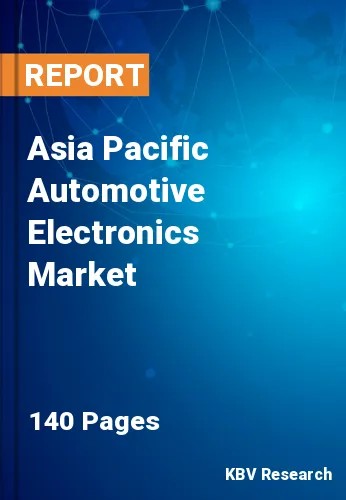The Asia Pacific Automotive Electronics Market would witness market growth of 9.2% CAGR during the forecast period (2023-2030).
Automotive electronics use electronic systems and vehicle components for various functions, such as vehicle control, communication, safety, entertainment, and connectivity. Such electronic components and systems are intended to improve automobiles' performance, efficiency, convenience, and user experience.
In recent years, consumer preferences for safety features, connectivity solutions, Advanced Driver Assistance Systems (ADAS), and Electronic Vehicles (EVs) have led to substantial growth in this market. In addition to powertrain electronics, advanced sensors, infotainment systems, control units, and telematics systems, the market incorporates various electronic systems and components utilized in automotive.
Artificial intelligence has made automobiles more intelligent. These autonomous vehicles detect peril and the driver's anxiety. Advanced control systems evaluate sensory information and recognize appropriate navigation paths, in addition to obstacles and pertinent signage, for self-driving autonomous vehicles that use a variety of sensors to sense their surroundings, like radars.
India’s transportation sector is highly robust, yet a considerable gap exists between fuel supply and demand. The transport sector in India consumes 18% of the total energy used by the nation, according to the Indian Bureau of Energy Efficiency. This business is particularly vulnerable to changes in the price of crude oil because imported crude oil now meets most of this demand. The sector is estimated to emit 142 million tons of CO2 annually, of which the road transport segment alone is responsible for 123 million tons. Therefore, the nation must develop alternative transportation systems that can accommodate India’s booming urbanization, increased travel demand, and energy security. As a result, the adoption of EVs is rising in the nation, and the government is also showing a positive attitude toward this. This increased trend of vehicle electrification and surging adoption of EVs is predicted to support the overall market growth in the APAC region.
The China market dominated the Asia Pacific Automotive Electronics Market by Country in 2022, and would continue to be a dominant market till 2030; thereby, achieving a market value of $51,468.7 million by 2030. The Japan market is registering a CAGR of 8.6% during (2023 - 2030). Additionally, The India market would showcase a CAGR of 9.9% during (2023 - 2030).
Based on Application, the market is segmented into Safety Systems, Powertrain Electronics, Infotainment, ADAS and Body Electronics. Based on Sales Channel, the market is segmented into OEM and Aftermarket. Based on Component, the market is segmented into Current Carrying Devices, Sensors, Electronic Control Unit and Others. Based on countries, the market is segmented into China, Japan, India, South Korea, Singapore, Malaysia, and Rest of Asia Pacific.
Free Valuable Insights: The Worldwide Automotive Electronics Market is Projected to reach USD 470.6 Billion by 2030, at a CAGR of 9.1%
The market research report covers the analysis of key stake holders of the market. Key companies profiled in the report include Continental AG, Robert Bosch GmbH, Sony Corporation, Aptiv PLC, Hyundai Mobis Co., Ltd. (Hyundai Motor), ZF Friedrichshafen AG, Infineon Technologies AG, Magna International, Inc., Aisin Corporation (Toyota Motor Corporation) and Koninklijke Philips N.V.
By Application
By Sales Channel
By Component
By Country
Our team of dedicated experts can provide you with attractive expansion opportunities for your business.

